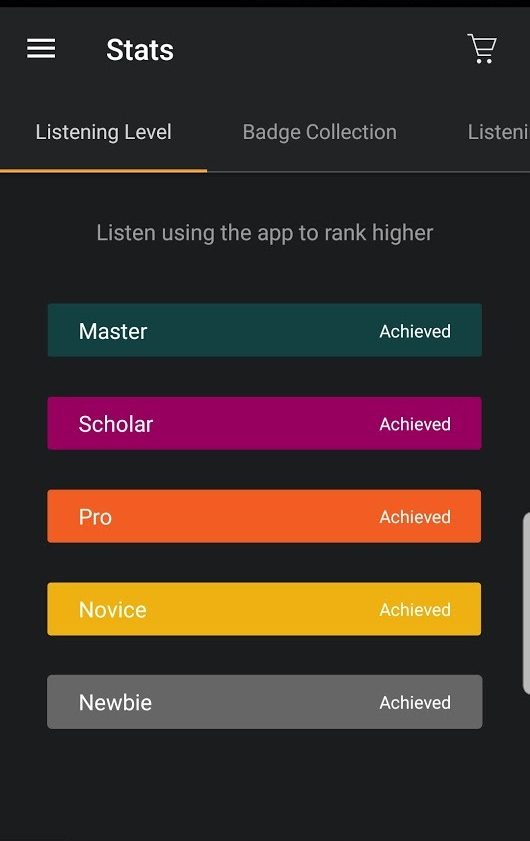Table of Contents
How to read more with Audible [01:37]
Main Idea
If you’ve ever wondered how to read more, especially with a busy schedule, I have the answer: Audible!
Audible is Amazon’s audio book service, and is one of the best services for which I’ve ever signed up. It was recommended to me by a friend back in 2015, and I’m so happy I decided to sign up.
I went from reading 0-1 books per year to reading 20-40 books per year! This is because I’m able to take advantage of time I wouldn’t ordinarily be able to use to read a physical book.
I’m going to walk you through all of the reasons why I love this service. And then, if you’re interested, you can sign up for a free trial of Audible, complete with TWO free books of your choice.
How Audible works
Here’s a quick rundown of how Audible works:
- It costs $14.95 / month. For that you get one credit
- Credits can be applied to any book in the Audible library
- Books are yours to keep, even if you cancel membership
- You can buy additional credits if you run out
- You can buy books out-of-pocket, too
- I often will purchase a book if it costs less than I spent on the credit
When to listen
Some typical times to listen:
- Cleaning: Whenever I’m cleaning, I’ll stick in some earbuds and read (listen) away!
- Workout: I find that listening to books while working out tires me out, but it might work for you
- Shower: I have a waterproof speaker and I spend lots of shower time listening to books
- Driving: My commute makes up about 80% of my reading time each month. This is my preferred time.
Tips for picking good books
Here are a few tips I have for making sure you pick books you’ll love:
- I typically only read a book if it has a 4.5 star rating
- I try to avoid the reviews themselves because they can bias you against things you don’t notice. A lot of reviewers comment on the narration, and they mention things that I wouldn’t usually notice otherwise. This meant that I spent the entire time listening to the book searching for the stuff the reviewers mentioned instead of listening to the content.
- Audible offers a sample of each book right on its page. Definitely listen to the samples if you’re curious about the narration.
Why I switched to the Platinum level
Audible has a Platinum level membership that they don’t make that obvious!
When I first started using Audible, I was going through two books almost every month. That meant I was spending $14.95 on one credit, and then the cost of the second book. So, I was spending $30+ each month.
I did a little bit of searching and discovered the Platinum level: It only cost $22.95, and you get two credits. Switching means I started saving money.
If you find that you read more than one book per month, this is definitely a great option!
My stats
Audible has a set of stats you can access on the mobile app. At first, I didn’t think I’d care about these stats. Now though, I enjoy checking the numbers and earning badges.
Here are a few of my stats:
- So far, I’ve read for 22 days, 4 hours, 41 minutes. That equals approximately 532 hours!
- I’ve reached the highest level — the Master level — Audible has. That means I’ve ready for 500+ hours.

- I have 79 titles in my library. I’ve read most of them!
- I’ve been an Audible member since late 2015
Here are some of the badges I’ve earned:

Try Audible
If you’re interested in trying Audible, you can grab a free trial and a free book! Hit the button below to head there now:
Retaining more information you’ve read [16:16]
Side Note
Because I love to learn, I read mostly non-fiction books. If you read mostly fiction, feel free to jump over this section!
While listening to audio books is great for overlapping reading with other tasks, I’ve found that I don’t retain as much information as I’d like.
So, just recently, I developed a method for retaining more:
- First, I get the physical book. I’ll either check it out at the library, or I’ll buy it
- Then, each weekend, I spend about an hour reviewing the material I read throughout the week
- I skim over the chapters in the physical book, and I take notes in my Moleskine notebook
- Give that this is a second pass over the material, I find that I retain a ton more!
Captivate & Resilient [19:46]
Bookshelf
This week, I’m introducing a new segment called BOOKSHELF. Periodically, I will update the BOOKSHELF with books I’ve read and love!
You can read about the books I’ve put on the shelf this week below.
You can also grab my free Bookshelf digital download. This is a running list of all of my book recommendations in one convenient place.
Captivate by Vanessa Van Edwards [21:14]
Book summary
As a human behavior hacker, Vanessa Van Edwards created a research lab to study the hidden forces that drive us. And she’s cracked the code. In Captivate, she shares shortcuts, systems, and secrets for taking charge of your interactions at work, at home, and in any social situation. These aren’t the people skills you learned in school. This is the first comprehensive, science backed, real life manual on how to captivate anyone—and a completely new approach to building connections.
Just like knowing the formulas to use in a chemistry lab, or the right programming language to build an app, Captivate provides simple ways to solve people problems. You’ll learn, for example…
- How to work a room: Every party, networking event, and social situation has a predictable map. Discover the sweet spot for making the most connections.
- How to read faces: It’s easier than you think to speed-read facial expressions and use them to predict people’s emotions.
- How to talk to anyone: Every conversation can be memorable—once you learn how certain words generate the pleasure hormone dopamine in listeners.
Three key takeaways
- Make a good first impression: Use the Launch stance
- Hands visible
- Head up
- Shoulders and chest back and down
- Make eye contact with the other person — notice their eye color
- For quality conversations, use conversation sparkers
- What’s the highlight of your day / week?
- Working on anything exciting lately?
- Working on any personal passion projects?
- End conversations by shifting focus to the future
- Start by asking a question like, “What are you up to this weekend?”
- Then, transition out of the conversation by saying something like, “I hope you have a great time ______ this weekend! Thanks for chatting with me!”
Resilient by Rick Hanson, Ph.D. [29:04]
Book summary
These days it’s hard to count on the world outside. So, it’s vital to grow strengths inside like grit, gratitude, and compassion – the key to resilience, and to lasting well-being in a changing world.
True resilience is much more than enduring terrible conditions. We need resilience every day to raise a family, work at a job, cope with stress, deal with health problems, navigate issues with others, heal from old pain, and simply keep on going.
With his trademark blend of neuroscience, mindfulness, and positive psychology, New York Times best-selling author Dr. Rick Hanson shows you how to develop 12 vital inner strengths hardwired into your own nervous system. Then no matter what life throws at you, you’ll be able to feel less stressed, pursue opportunities with confidence, and stay calm and centered in the face of adversity.
This practical guide is full of concrete suggestions, experiential practices, personal examples, and insights into the brain. It includes effective ways to interact with others and to repair and deepen important relationships.
Warm, encouraging, and down-to-earth, Dr. Hanson’s step-by-step approach is grounded in the science of positive neuroplasticity. He explains how to overcome the brain’s negativity bias, release painful thoughts and feelings, and replace them with self-compassion, self-worth, joy, and inner peace.
Three key takeaways
- Think of the mind like a garden. You can:
- Observe a garden (examine thoughts, or let be)
- Pull weeds (prune negative thoughts, or let go)
- Plant flowers (encourage positive thoughts, or let in)
- Learning happens by deliberate, repeated action
- Dr. Hanson says that neurons that fire together wire together
- We can hard-wire positive experiences into our brains by deliberately enhancing and absorbing them.
- These positive experiences can occur naturally, or they can be created
- You can use Hanson’s HEAL steps for this:
- H: Have a positive experience
- E: Enrich that experience
- A: Absorb it
- L: Link it to negative experiences to begin healing those
- Dr. Hanson covers, in-depth, the practical ways to use these steps in the book! It goes far beyond the surface-level metaphor and gives practical, real steps to take.
Don’t forget!
Try Audible
Audible is an amazing service, and I’m sure you’ll love it. If you sign up, you get a free book of your choice, and you can keep it whether or not you subscribe!
Get the Free Download!
15 Strategies for Getting More Done in a Day
I have a fantastic freebie I'd love to send to you. It's a one-page guide that covers my favorite 15 strategies for making the most out of every day.
Click below to grab this download now!



